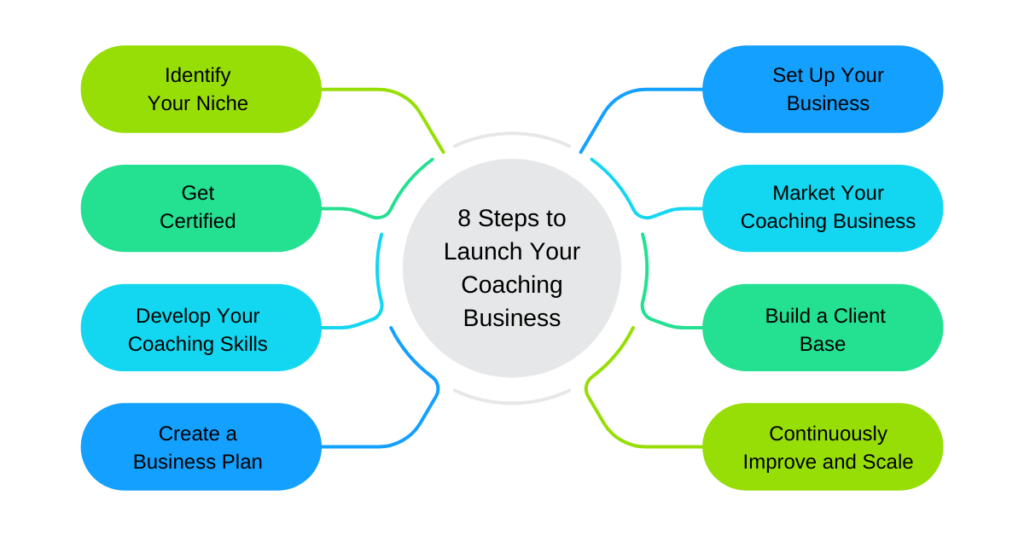Starting a coaching business is your chance to turn passion into profit by helping others achieve their goals. Whether you’re a life coach, career strategist, or fitness mentor, the demand for personalized guidance has never been higher.
But before you dive in, you’ll need a clear roadmap to launch successfully. In this ultimate guide, we’ll break down the essential steps to kickstart your coaching journey and build a thriving business from scratch.
Ready to turn your expertise into a rewarding venture? Let’s get started!
The 8 Steps to Launch Your Coaching Business

Starting your coaching business requires careful planning and execution. Follow these eight essential steps to set a strong foundation for your coaching business:
Step 1: Identify Your Niche
Before you begin, pinpoint your area of expertise. Your niche should align with your knowledge and passion. Some popular coaching niches include:
- Life Coaching: This involves helping individuals achieve personal goals and improve various aspects of their lives, such as relationships, personal development, and work-life balance.
- Business Coaching: In this role, you’ll assist entrepreneurs and business owners in growing their ventures. You might focus on strategies for scaling, enhancing leadership skills, or streamlining operations.
- Health Coaching: As a health coach, you’ll guide clients towards their wellness goals. This can encompass nutritional advice, fitness planning, and stress management techniques.
- Career Coaching: Help individuals navigate career transitions, improve their job search strategies, and develop professional skills.
- Relationship Coaching: Guide couples and individuals in improving their personal and professional relationships.
Selecting a niche allows you to target the right audience and stand out in a competitive market. Consider your unique skills and experiences to further refine your focus.
For instance, if you have a background in corporate leadership, you might specialize in executive coaching. Alternatively, if you’ve overcome significant personal challenges, you could focus on life coaching for resilience and personal growth.
Step 2: Get Certified
While certification isn’t mandatory, it significantly boosts your credibility as a coach. Look for reputable coaching programs that offer comprehensive training and certification. Organizations like the International Coach Federation (ICF) provide widely recognized certification programs.
The certification process typically involves:
- Completing a set number of training hours
- Gaining hands-on experience through coaching sessions
- Passing a rigorous exam
During your training, you’ll learn various coaching models and techniques, ethical guidelines, and strategies for handling different coaching scenarios. This structured approach ensures you’re well-equipped to meet your clients’ diverse needs.
Step 3: Develop Your Coaching Skills
Effective coaching hinges on strong communication, empathy, and problem-solving abilities. Continuously work on honing these skills through targeted training, practice, and feedback. Joining coaching communities and attending workshops can further enhance your capabilities.
Communication forms the foundation of coaching. Practice active listening by fully focusing on your client, understanding their message, and responding thoughtfully.
Empathy allows you to form deeper connections with clients, fostering trust and openness. Sharp problem-solving skills help you guide clients through challenges and develop actionable plans.
Consider participating in peer coaching sessions where you can practice your skills and receive constructive feedback. Reading extensively on psychology and human behavior and attending relevant seminars can provide valuable insights to enhance your coaching effectiveness.
Step 4: Create a Business Plan
A well-crafted business plan serves as the roadmap for your coaching venture. It should outline your goals, target audience, marketing strategies, and financial projections. This plan will help you stay organized and focused on your objectives.
Begin with an executive summary that provides an overview of your business. Then, define your mission statement, clearly articulating your purpose and what you aim to achieve through your coaching services. Identify your target audience, detailing their demographics, needs, and pain points.
Your marketing strategy should encompass both online and offline methods to attract clients. Online strategies might include content marketing, social media engagement, and email campaigns, while offline methods could involve networking events, workshops, and speaking engagements. Financial projections should cover your startup costs, pricing strategy, and revenue goals.
In addition, include a SWOT analysis (Strengths, Weaknesses, Opportunities, and Threats) to assess your competitive position in the market.Be sure also to outline your unique value proposition, clearly stating what sets your coaching services apart from others in your niche.
More importantly, make it a habit to review and update your business plan regularly, adapting to changes in the market and your business growth.
Step 5: Set Up Your Business
To launch your coaching business, you’ll need to address several practical aspects:
Register Your Business:
Choose a distinctive name and register your business according to local regulations. This step also involves selecting a business structure, such as a sole proprietorship, partnership, or limited liability company (LLC).
Create a Website:
A professional website is essential for attracting clients. Include detailed information about your services, credentials, and client testimonials. Ensure your website features a clean layout, intuitive navigation, and search engine optimization to boost its visibility.
Set Your Rates:
Research industry standards and set competitive rates for your coaching sessions. Consider offering a variety of packages, such as one-on-one sessions, group coaching, and long-term coaching programs. Providing multiple options can appeal to a wider range of clients.
Choose the Right Tools and Platforms:
To run your coaching business efficiently, invest in tools that streamline communication and organization. This could include scheduling software, video conferencing platforms (e.g., Zoom), and customer relationship management (CRM) systems to track client progress. Additionally, consider using project management tools to handle administrative tasks like invoicing, note-taking, and session reminders, freeing up your time to focus on coaching.
Secure Insurance:
Liability insurance is another practical consideration to protect your business. Depending on your area, it might be essential to have professional liability insurance, also known as errors and omissions insurance, which covers legal expenses if a client claims negligence or unsatisfactory results.
It’s a small investment that can safeguard your business from unexpected legal issues.
Set Up Business Finances:
Lastly, separate your personal and business finances by opening a dedicated business bank account. This makes it easier to manage your cash flow, track expenses, and handle taxes. Consider hiring an accountant or using accounting software to manage bookkeeping, payroll, and tax obligations as your business grows.
Step 6: Market Your Coaching Business
Effective marketing is key to attracting clients. Here are some proven strategies:
Content Marketing:
Produce valuable blog posts, videos, or webinars on topics related to your niche. This establishes you as an expert and draws potential clients. For example, if you’re a health coach, write about effective nutrition strategies or create workout tutorial videos.
Social Media:
Leverage platforms like LinkedIn, Facebook, and Instagram to engage with your audience and share valuable content. Maintain a consistent posting schedule, interact with your followers, and join relevant groups and discussions.
Networking:
Attend industry events, join professional groups, and connect with other coaches and potential clients. Building relationships in your field can lead to referrals and collaboration opportunities.
Collaboration with Other Businesses:
Partner with businesses that serve your target audience but don’t compete directly with you. This can help you tap into established customer bases, expand your network, and create mutually beneficial referral systems, ultimately leading to increased visibility and client acquisition for your coaching business.
Email List Building:
Consider offering free resources, such as e-books or guides, in exchange for email subscriptions. This helps you build an email list, which you can use for targeted marketing campaigns. Regularly update your audience with valuable content, promotions, and success stories to keep them engaged and interested in your services.
Step 7: Build a Client Base
Start by offering complimentary or discounted sessions to gather testimonials and establish your reputation. Encourage satisfied clients to refer your coaching services to others. As you gain more clients, focus on delivering exceptional service to retain and grow your client base.
Client testimonials are powerful marketing tools. They serve as social proof, enhancing your credibility and building trust with potential clients. Ask clients to leave reviews on platforms like Google and Yelp to boost your online reputation.
Develop a smooth client onboarding process to ensure a professional start to your coaching relationships. This might include an initial consultation, setting clear expectations, and outlining the coaching process. Regularly check in with clients to assess their progress and refine your methods.
Step 8: Continuously Improve and Scale
Never stop learning and improving your coaching skills. As your business grows, consider scaling by offering group coaching sessions, online courses, or bringing additional coaches on board.
Attend workshops, conferences, and courses to stay current with the latest coaching methodologies and tools. Join professional coaching associations to network with other coaches and access valuable resources. Consistently seek client feedback to identify areas for improvement and make necessary adjustments.
Scaling your business involves expanding your reach and offerings. Group coaching sessions allow you to work with multiple clients simultaneously, increasing your impact and revenue.
Online courses can provide passive income and reach a global audience. As your clientele expands, consider hiring additional coaches to meet the increased demand and offer specialized services.
Conclusion
Starting a coaching business requires careful planning, dedication, and ongoing improvement. Following this comprehensive guide will prepare you to build a thriving and fulfilling coaching career. Your commitment to helping others and your pursuit of excellence will be the foundation of your success.

We empower people to succeed through information and essential services. Do you need help with something? Contact Us.
Want a heads-up once a week whenever a new article drops?







